Re: The Gilpin Tram in Black Hawk
Posted by Keith Pashina on Mar 23, 2023; 9:51pm
URL: http://c-sng-discussion-forum.254.s1.nabble.com/The-Gilpin-Tram-in-Black-Hawk-tp18436p18541.html
GILPIN TRAM ENGINEHOUSE AREA
Across Clear Creek from the Gilpin Tram’s warming house was the engine house, a small yard, wye, and shops. The Gilpin Tram referred to their engine house as the “roundhouse,” but there was nothing round about it.
The Gilpin Tramway purchased and modified a former horse barn on the north side of Black Hawk, about 1/4 mile north of town. In the narrow Clear Creek Canyon, there wasn’t much real estate available for railroad tracks and buildings, so reusing a conveniently located barn fit in well with the Gilpin Tramway’s inexpensive construction philosophy. An early photograph shows that the barn was modified by cutting in a door for one locomotive stall at the west end, for the Gilpin Tramway’s first locomotive. The barn also may have been sheathed in metal siding around this time.
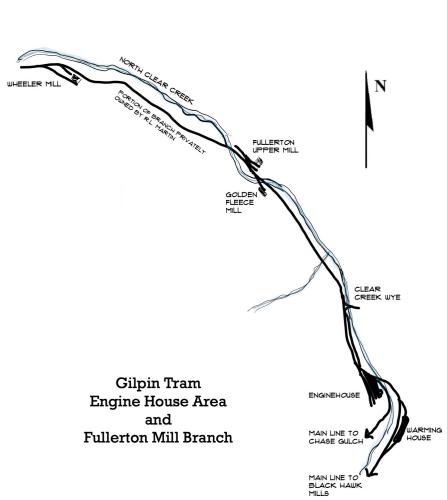
A map showing the enginehouse and yards area, and Fullerton Mill branch north of there. This and the next few posts will cover this area.
Later on, as the roster grew, an extension was added to the west side, and the barn, now called a roundhouse by the Gilpin Tramway, was modified for 3 locomotive stalls. These stalls were very small, built just wide enough and tall enough for the railroad’s diminutive shays to fit inside. The end stall was built slightly wider and taller than the other two stalls, probably when the larger Shay #5 was purchased.
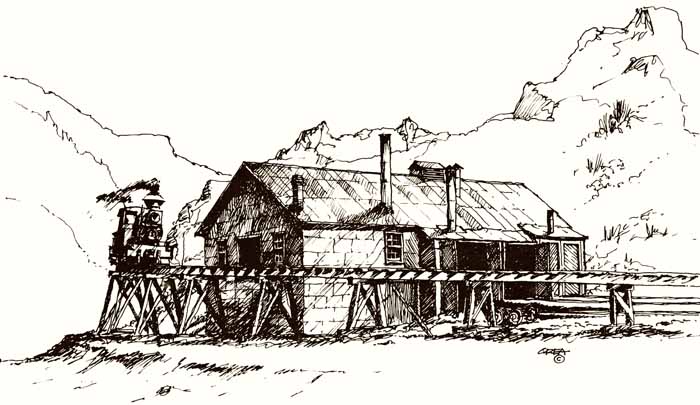
A wonderful sketch by Joe Crea, showing the enginehouse with themain line trestle passing by. This depicts the “final” version of the engine house, when it had been enlarged to three stalls.
The engine house was set right next to the main line that headed up Chase Gulch, and eventually, to the mines. The main was on a wooden trestle, needed to gain elevation around a rock outcrop and pass over part of Clear Creek. The trestle was so close, that a corner of the roof was notched to allow clearance! Later on, the trestle was at least partially filled in with soil.
The Gilpin Tramway also built a few other buildings on this site. A small shed, possibly to house flammable paint or oils, sat in front of the engine house. And of course, directly across the river was a warming house, where loaded ore cars were parked overnight and thawed out during cold winter months.
Sanborn maps also show a two-stall car shed built at the ends of the two spurs that ran next to the engine house. I have never seen a clear photograph of this building, but it first shows up on the 1895 insurance company map.
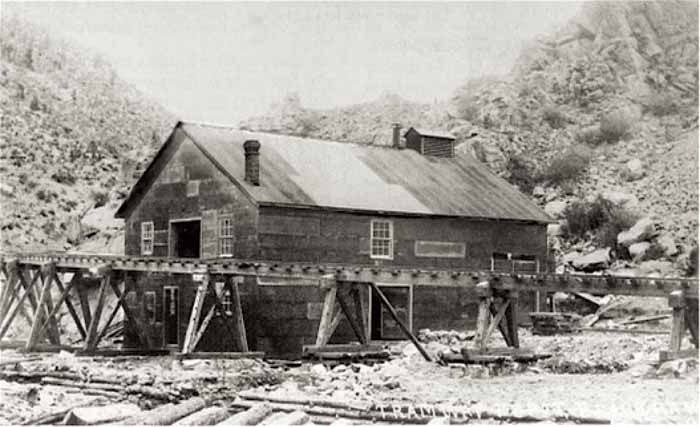
At first, the engine house was a single stall, as the tram only had the one locomotive. This would be later expanded to two, and finally three stalls. The origins as a horse barn are evident here, even though contemporary news sources refer to this as the “roundhouse”(from Denver Public Library, Western History Collection, image Z-3481).
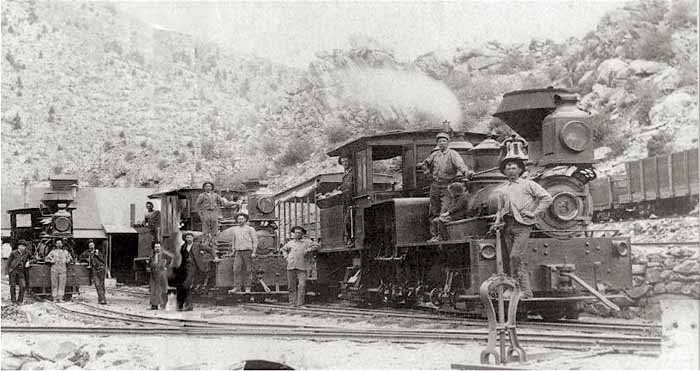
By now, Shays 1, 2, and 3 were on the property, and proudly lined up for this photo by the engine house. This image is from Denver Public Library, Western History Collection, image Z-3476).
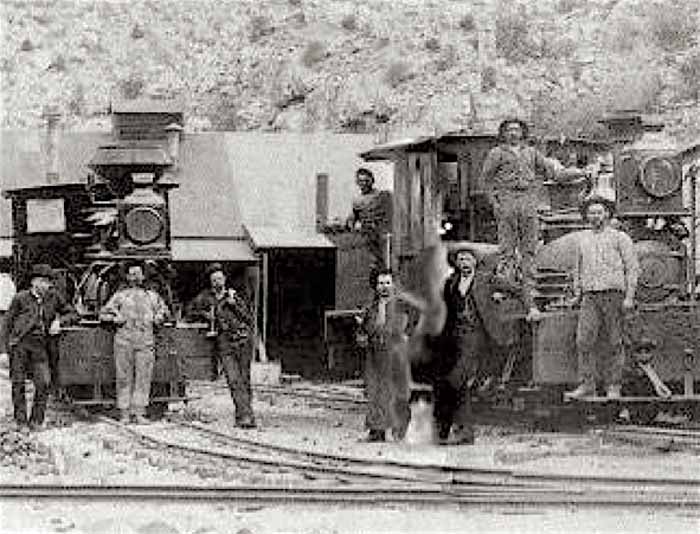
A closeup of the same image as above shows some more details of the doors to the engine house stalls.
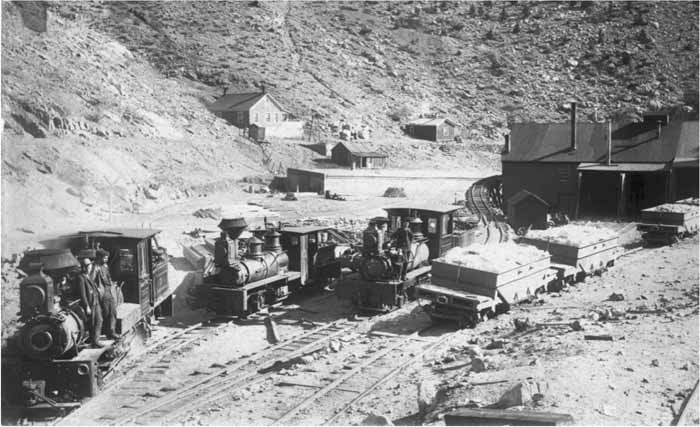
This photo shows Shays 1, 2 and 3 again at the engine house. The warming house can be seen across the creek. There are two tracks next to and up the slope from the engine house, apparently used for classifying cars to be switched to the mills, and for excess car storage. This image is from Denver Public Library, Western History Collection, image Z-187).
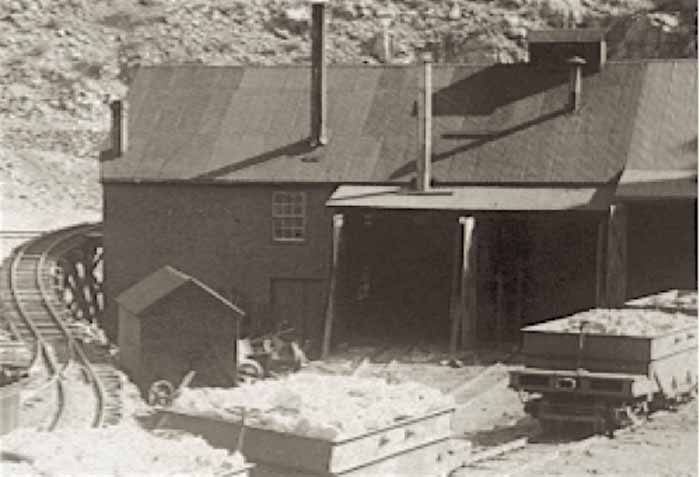
A closeup from the same image as above, shows a small shed in front of the engine house. This shed may have been used to store flammable materials, such as oil, grease, and paint.
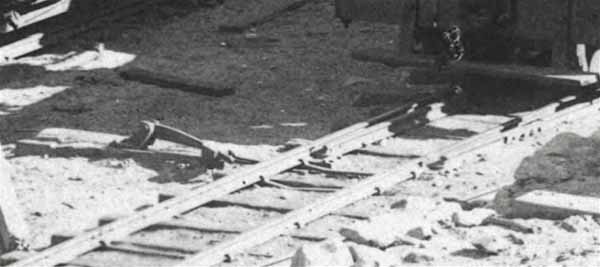
Another close-up of the same image – showing a ground throw for one of the turnouts in front of the enginehouse. Chris Walker originally discovered this while scrutinizing images of the area.
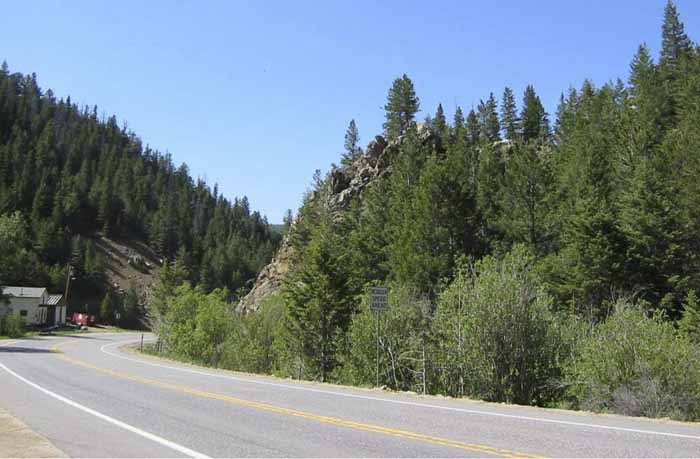
If you visit the engine house today – you will likely get your feet wet, and find – nothing. During a low-water month, I walked across the creek, and could not find much, Some small pieces of wood, sheet metal, and brick, but no foundations or any indication a railroad had ever been here. Highway 119 construction appears to have altered the creek bed location, from Gilpin Tram days,too.
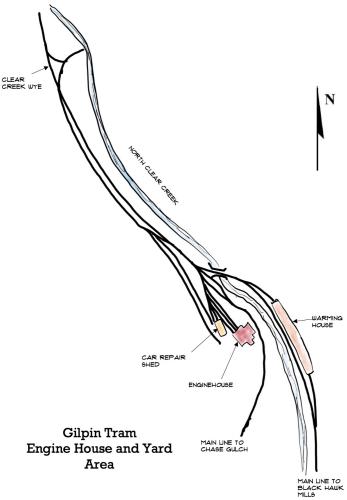
This map shows an overall view of the enginehouse and yard area
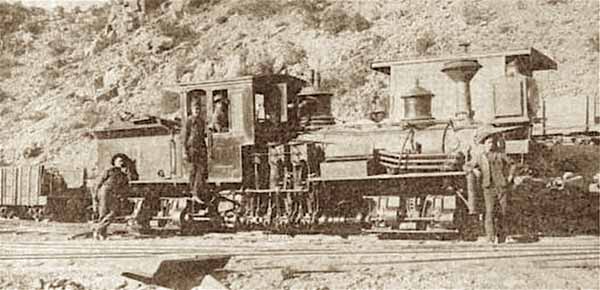
Shay #3 is posed in the tracks immediately in front of the engine house. Behind it, one of the caboises and one of the coal cars can be seen on the storage tracks. This image came from a Brotherhood of Locomotive Engineers 1903 magazine article.
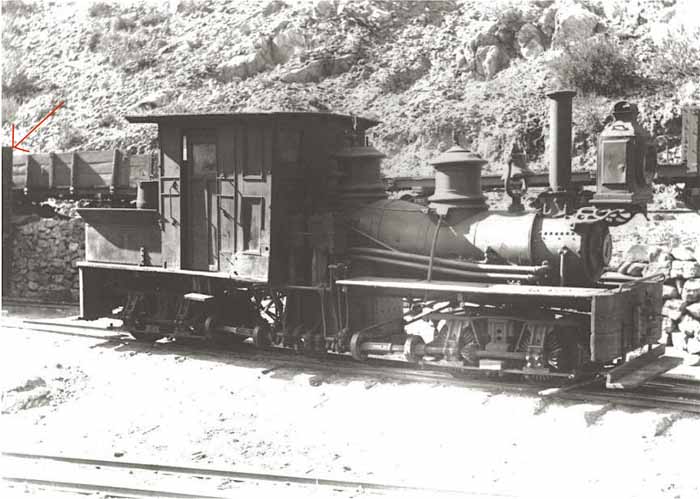
Shay #1 was the first locomotive, and was sold off in 1905 to the Silver City, Pinos Altos and Mogollon Railway in New Mexico. Here appears to be stored, possibly prior to its sale. Note the red arrow at left margin – it points to what appears to be one of the doors to the car shop. No other image of the car shop appears to be available. Image from the Colorado Historical Society, image CHS.X9533.
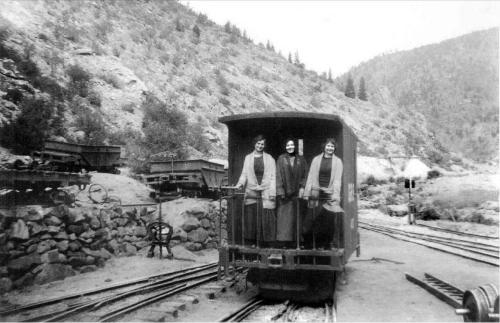
This image shows three young ladies on the end platform of Caboose 400, constructed after the C&S purchase. Note there are three types of switchstands in use in the yard area – the much-abused harp switchstand that no longer has its target, a rotary stand (to the right of the caboose), and the ground throw previously show in this post. Photo courtesy Mark Baldwin collection.
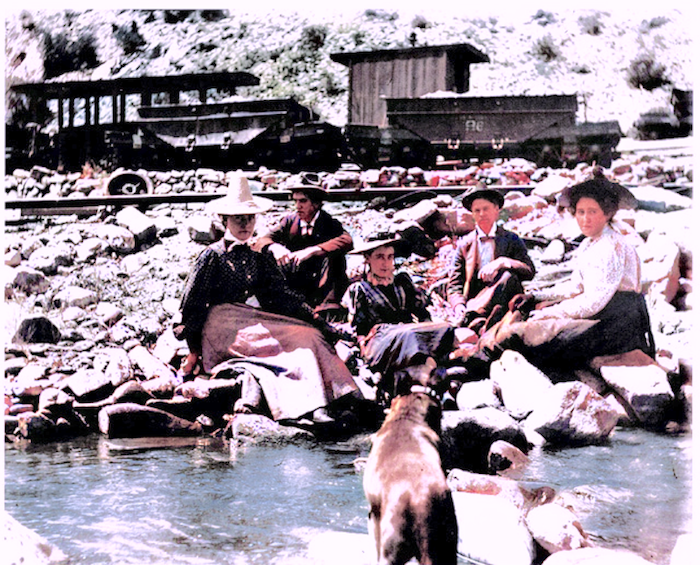
I couldn’t resist trying out a photo app to colorize this photo. I don’t know if the colors are correct or not, but it does bring the little group touring the area to loife. Note an excursion car, caboose, and three ore cars in the background. Photo courtesy Mark Baldwin collection.
URL: http://c-sng-discussion-forum.254.s1.nabble.com/The-Gilpin-Tram-in-Black-Hawk-tp18436p18541.html
GILPIN TRAM ENGINEHOUSE AREA
Across Clear Creek from the Gilpin Tram’s warming house was the engine house, a small yard, wye, and shops. The Gilpin Tram referred to their engine house as the “roundhouse,” but there was nothing round about it.
The Gilpin Tramway purchased and modified a former horse barn on the north side of Black Hawk, about 1/4 mile north of town. In the narrow Clear Creek Canyon, there wasn’t much real estate available for railroad tracks and buildings, so reusing a conveniently located barn fit in well with the Gilpin Tramway’s inexpensive construction philosophy. An early photograph shows that the barn was modified by cutting in a door for one locomotive stall at the west end, for the Gilpin Tramway’s first locomotive. The barn also may have been sheathed in metal siding around this time.

A map showing the enginehouse and yards area, and Fullerton Mill branch north of there. This and the next few posts will cover this area.
Later on, as the roster grew, an extension was added to the west side, and the barn, now called a roundhouse by the Gilpin Tramway, was modified for 3 locomotive stalls. These stalls were very small, built just wide enough and tall enough for the railroad’s diminutive shays to fit inside. The end stall was built slightly wider and taller than the other two stalls, probably when the larger Shay #5 was purchased.

A wonderful sketch by Joe Crea, showing the enginehouse with themain line trestle passing by. This depicts the “final” version of the engine house, when it had been enlarged to three stalls.
The engine house was set right next to the main line that headed up Chase Gulch, and eventually, to the mines. The main was on a wooden trestle, needed to gain elevation around a rock outcrop and pass over part of Clear Creek. The trestle was so close, that a corner of the roof was notched to allow clearance! Later on, the trestle was at least partially filled in with soil.
The Gilpin Tramway also built a few other buildings on this site. A small shed, possibly to house flammable paint or oils, sat in front of the engine house. And of course, directly across the river was a warming house, where loaded ore cars were parked overnight and thawed out during cold winter months.
Sanborn maps also show a two-stall car shed built at the ends of the two spurs that ran next to the engine house. I have never seen a clear photograph of this building, but it first shows up on the 1895 insurance company map.

At first, the engine house was a single stall, as the tram only had the one locomotive. This would be later expanded to two, and finally three stalls. The origins as a horse barn are evident here, even though contemporary news sources refer to this as the “roundhouse”(from Denver Public Library, Western History Collection, image Z-3481).

By now, Shays 1, 2, and 3 were on the property, and proudly lined up for this photo by the engine house. This image is from Denver Public Library, Western History Collection, image Z-3476).

A closeup of the same image as above shows some more details of the doors to the engine house stalls.

This photo shows Shays 1, 2 and 3 again at the engine house. The warming house can be seen across the creek. There are two tracks next to and up the slope from the engine house, apparently used for classifying cars to be switched to the mills, and for excess car storage. This image is from Denver Public Library, Western History Collection, image Z-187).

A closeup from the same image as above, shows a small shed in front of the engine house. This shed may have been used to store flammable materials, such as oil, grease, and paint.

Another close-up of the same image – showing a ground throw for one of the turnouts in front of the enginehouse. Chris Walker originally discovered this while scrutinizing images of the area.

If you visit the engine house today – you will likely get your feet wet, and find – nothing. During a low-water month, I walked across the creek, and could not find much, Some small pieces of wood, sheet metal, and brick, but no foundations or any indication a railroad had ever been here. Highway 119 construction appears to have altered the creek bed location, from Gilpin Tram days,too.

This map shows an overall view of the enginehouse and yard area

Shay #3 is posed in the tracks immediately in front of the engine house. Behind it, one of the caboises and one of the coal cars can be seen on the storage tracks. This image came from a Brotherhood of Locomotive Engineers 1903 magazine article.

Shay #1 was the first locomotive, and was sold off in 1905 to the Silver City, Pinos Altos and Mogollon Railway in New Mexico. Here appears to be stored, possibly prior to its sale. Note the red arrow at left margin – it points to what appears to be one of the doors to the car shop. No other image of the car shop appears to be available. Image from the Colorado Historical Society, image CHS.X9533.

This image shows three young ladies on the end platform of Caboose 400, constructed after the C&S purchase. Note there are three types of switchstands in use in the yard area – the much-abused harp switchstand that no longer has its target, a rotary stand (to the right of the caboose), and the ground throw previously show in this post. Photo courtesy Mark Baldwin collection.

I couldn’t resist trying out a photo app to colorize this photo. I don’t know if the colors are correct or not, but it does bring the little group touring the area to loife. Note an excursion car, caboose, and three ore cars in the background. Photo courtesy Mark Baldwin collection.
Keith Pashina
Narrow-minded in Arizona
Narrow-minded in Arizona
| Free forum by Nabble | Edit this page |